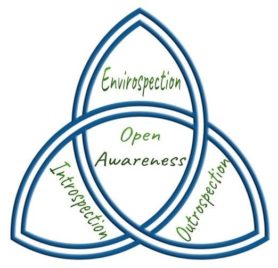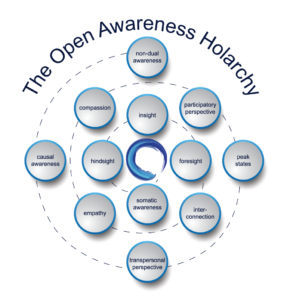
Mindfulness, bodyfulness and open awareness are 3 sides of the same coin. This article describes their commonalities and differences, as well as their applications in terms of personal growth and transpersonal development.
As new sicknesses arise and the world’s problems proliferate, it’s clear that new solutions are needed. Many of the significant problems the world faces today, whether personally,- environmentally,- socially,- economically,- and others are issues that stem (at least in part) from a lack of awareness of our multidimensional interrelatedness in the vast web of life. According to Albert Einstein, seeing ourselves as individual disconnected entities in the universe is an optical delusion of consciousness (Einstein, 1977). He recognised that in order to solve the problems that we experience on one level, we require expanded levels of perception. Tunnel awareness (a limited perception of oneself in relation to one’s surroundings) is a contributory cause of why we experience ourselves as separate form everyone and everything else in life, which in turn leads us to behave destructively toward ourselves, others and our environment. In this article I will point out how a mindfulness related approach which I refer to as “open awareness” can broaden ones level of perception, leading from self-concept to Self realisation, and thus be of healing and transformative value to humans and our world.

Tunnel awareness can be understood as a narrowed focus of attention that deletes everything in the periphery of one’s field of awareness from ones personal consciousness. The fight and flight response is associated with being in tunnel awareness, as in this state one usually identifies only the perceived danger while deleting whatever else is not necessary in our field of awareness in order to survive a life threatening situation. One may behave similarly in situations that are not threatening to one’s life, but considered by the individual to be unpleasant or disturbing, where one remains fixated on the object of negative reference while all other points of reference, including the quality of one’s own thoughts and feelings are negated (Drummond, D. n.d). Those who experience overwhelming stress or the burnout syndrome are usually stuck in a form of tunnel awareness, whereby that which perpetuates the problem is what one’s attention remains focussed on, thus the problem remains a problem. Satisfying solutions might only be discovered when the individual succeeds in shifting their state of consciousness in a way that enables them to dis-identify from their limited self-concept. This could be facilitated through expanding the sense of self and establishing a broader perspective, which in turn may increase one’s awareness of choices beyond those that are determined through identification with the limited self-concept.
Each state of consciousness offers a different view of reality, thus one’s perception of reality is only partially true, therefore one’s state of consciousness determines one’s current model of the world (Walsh & Vaughn, 1980). On this basis, expanding one’s experience of self in a manner that includes shifting one’s state of consciousness into a calm and receptive mode – not only enables one to see the bigger picture, but also experience oneself differently in relation to one’s environment and the circumstances that are associated with it. Hunt (2007) considers transformation to be possible through a more complete letting go of the ordinary boundaries of self in order to reveal the more subtle levels of the Unconscious. Open awareness enables one to release identification with the self-concept and become aware of the more subtle levels of consciousness that are normally beyond our level of perception. In discussing his own model of self-expansiveness, Harris Friedman (2013) explains:
Self-expansiveness rests on the view that the self-concept can be relatively narrowly construed, limited to the isolated individual bound in the here-and-now of the present, or can expand to include others, nature, and even a transpersonally constituted identity where the sense of self can extend to allow for boundless identity with all of nature (p. 204).
Friedman suggests that transpersonal self-expansiveness and its cartography unifies all perspectives of the self-concept within a single holistic framework (Ibid p. 207). In terms of transpersonal healing and growth Friedman points out that beyond the framework of his construct, another self expanding strategy might be “dis-identification”, provided it is not taken to extremes (Ibid p.213). The process of open awareness focusses primarily on enabling individuals to dis-identify from their self-concept through facilitating an expanded sense of self that transcends one’s direct experience of space. More specifically, open awareness assists one to identify all sensory experiences within one’s field of awareness, as opposed to these being experienced outside or separate from them. Those whom I have guided to experience the expanded state induced through the practice of open awareness often report that the boundaries between self and not self seem to dissolve, bringing about a sense that all experiences unfold within the Self (a felt sense of oneness with everything in awareness). Feelings of being interconnected with all things are common when practising peripheral awareness in the same way consciousness researchers have described the effects of other transpersonal practices (e.g. Fadiman, Grob, Griffiths, Nichols, C., Nichols, D., et al., 2009) and thus identification with the self-concept is replaced (although sometimes only temporarily) with a more encompassing and seemingly infinite experience of Self. The process ends by embodying the expanded state (feeling it in the physical form) and then choosing how to approach challenging situations from the point of view of the Self (or while the individual is experiencing a holotropic state of consciousness (Stanislav Grof’s term for “moving toward wholeness” (2000). Depending on the individual and their reason for practising open awareness, the experience of Self fluctuates and is therefore not an ultimate state, but rather one in which the individual experiences a felt sense of expansiveness and interconnection resulting from dis-identification from a limiting self-concept.
Open awareness in relation to mindfulness and bodyfulness
While until now empirical evidence for the value of open awareness remains mostly reserved for those who undertake the practice, scientific data does at least validate the calm and relaxed state of well-being due to parasympathetic nervous system activation that the skill stimulates (e.g. Hanson, 2011 and Farb, et al. 2007). Both open awareness and mindfulness (the way in which it is most commonly known in the West) involve establishing present moment awareness and being non-judgemental. There is however one fundamental difference in the two practices that I will outline here.
Some Westernised mindfulness practices deliberately bring intentionality to the present moment, for example: watching thoughts, abstaining from judgments, accepting feelings, etc. With open awareness, the only intention is to open the aperture of one’s awareness. This kind of opening of one’s field of awareness naturally in and of itself calms the mind, enhances one’s sensory acuity and cultivates a sense that all things (in one’s present experience) are constantly unfolding and interlinked processes within one’s awareness, where the boundaries between subject and object seem to dissolve. This leads to a sense of interconnection with others (which results in compassion) and the world ‘around’ us (which seems more within us at this stage). One feels expanded, peaceful and there is little self talk or none at all. Any self talk that may be judgemental can be quite easily heard as the voice of one’s self-concept (or ego) from which one has dis-identified, thus it has no significant influence.
Many practitioners would likely agree that the objective of performance enhancing skills, as well as plenty types of meditation and spiritual practices is to embody them, so that they become one’s automatic response in the relevant contexts of life. Bodyfulness (Ferrer, 2008) is when no trace of conscious intention is present, yet the individual reflexively responds to experiences in a mindful, compassionate and wise manner. Practitioners of open awareness have found that it has more of a being nature to it with little intentionality, while mindfulness practice (in the common Western approach) has a slightly more doing nature to it, with more intentionality. On this basis open awareness leads to bodyfulness with relative ease through practice and sooner or later (depending on the individual) almost no intention is required in order for open awareness to become embodied and therefore an enduring state. Open awareness is not being advocated as superior to mindfulness, but rather as a helpful approach to achieve mindfulness and to more easily embody a mindful approach to life in general.
The experience of activating transpersonal states and perspectives such as open awareness, as outlined above, suggests that one’s sense of self (self-concept) can become expanded to be more inclusive of phenomena that might ordinarily be unconscious or experienced as separate from oneself. Additionally, a mindful orientation is also being associated with open awareness, and as such, applications of this approach can be useful in the context of transpersonal coaching.
Written by Jevon Dangeli – Transpersonal Coach, MSc Transpersonal Psychology
> Live Transpersonal Coach training
> Online Transpersonal Coach training
Related articles:
- Introduction to Transpersonal Coaching
- The Transpersonal Coach Model
- Transformation in Transpersonal Coaching
- The Healing Potential of Transpersonal Coaching
- Transpersonal Psychology – New Perspectives
- Open Awareness (a transpersonal coaching skill)
- The mindful remedy for stress and burnout
- Bouncing back from burnout
References:
Einstein, A. (1977). Quoted in H Eves Mathematical Circles Adieu, Boston.
Fadiman, J., Grob, C., Griffiths, R., Nichols, C., Nichols, D.,Passie, T., Presti, D., Vollenweider, F. (2009). National Geographic Explorer. Inside LSD. Washington D.C. National Geographic Society. Retrieved from The World Wide Web, June 5 2014, https://www.youtube.com/watch?v=eqQzsMz_hD4
Farb, N.A.S., Segal, Z.V., Mayberg, H., Bean, J., McKeon, D., Fatima, Z., and Anderson, A.K. (2007). Attending to the present: Mindfulness meditation reveals distinct neural modes of self-reflection. SCAN, 2, 313-322.
Friedman H.L. and Hartelius G. Eds. (2013) The Wiley-Blackwell Handbook of Transpersonal Psychology, First Edition.
Grof, S. (2000). Psychology of the future, New York: State University of New York Press.
Hanson, R. (2011). Buddha’s Brain, Lighting up the Neural Circuits of Happiness, Love, and Wisdom. Retrieved from The World Wide Web, June 27 2013, http://www.rickhanson.net/wp-content/files/SlidesEsalenBBSept2011.pdf)
Hunt, T. (2007). Dark Nights of the Soul: Phenomenology and Neurocognition of Spiritual Suffering in Mysticism and Psychosis. The American Psychological Association Review of General Psychology. Vol. 11, No. 3.
Overdurf, J. (2013). Personal communication, June 20.
Walsh, R and Vaughan, F. (1980). Journal of Humanistic Psychology 20, 5-31.

